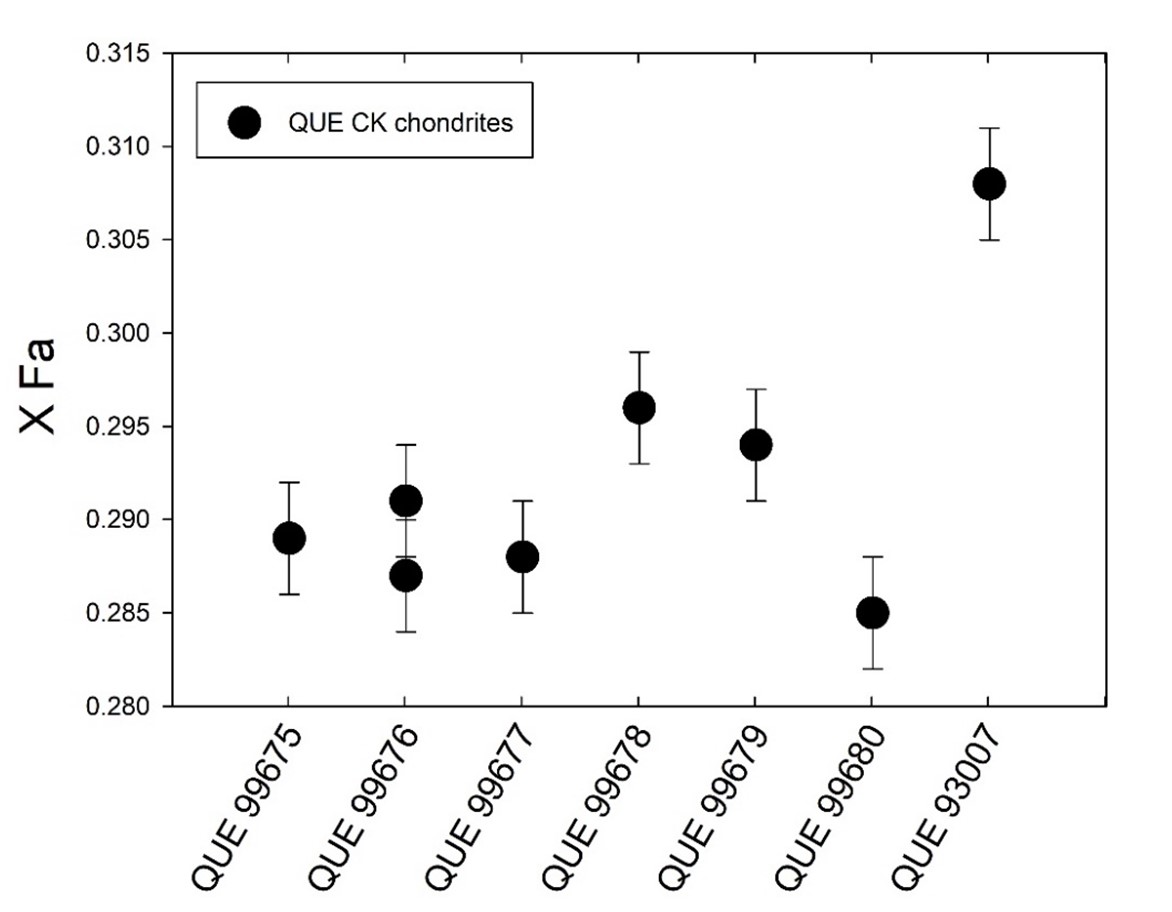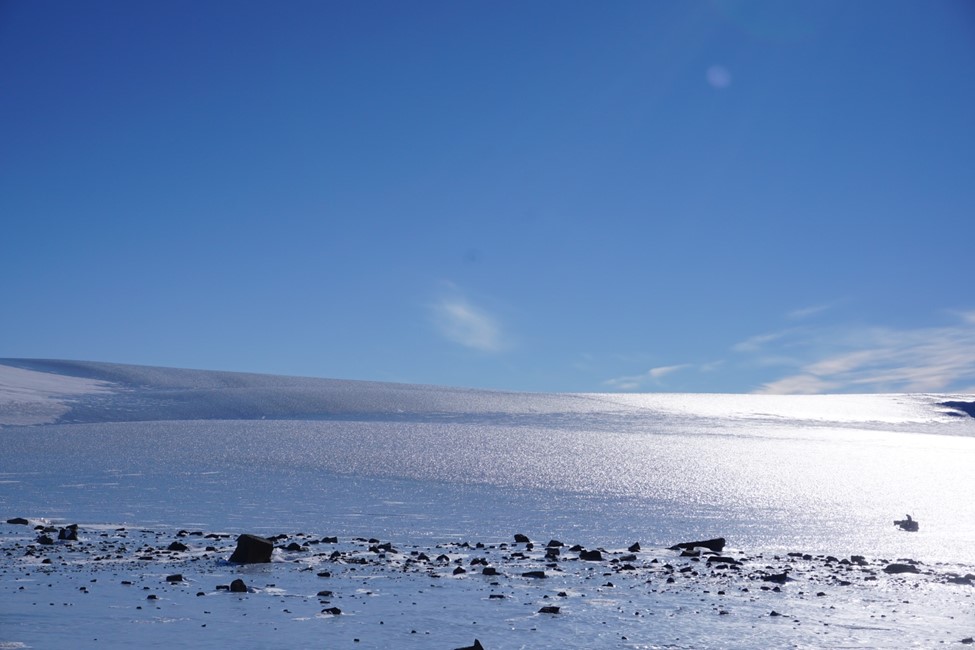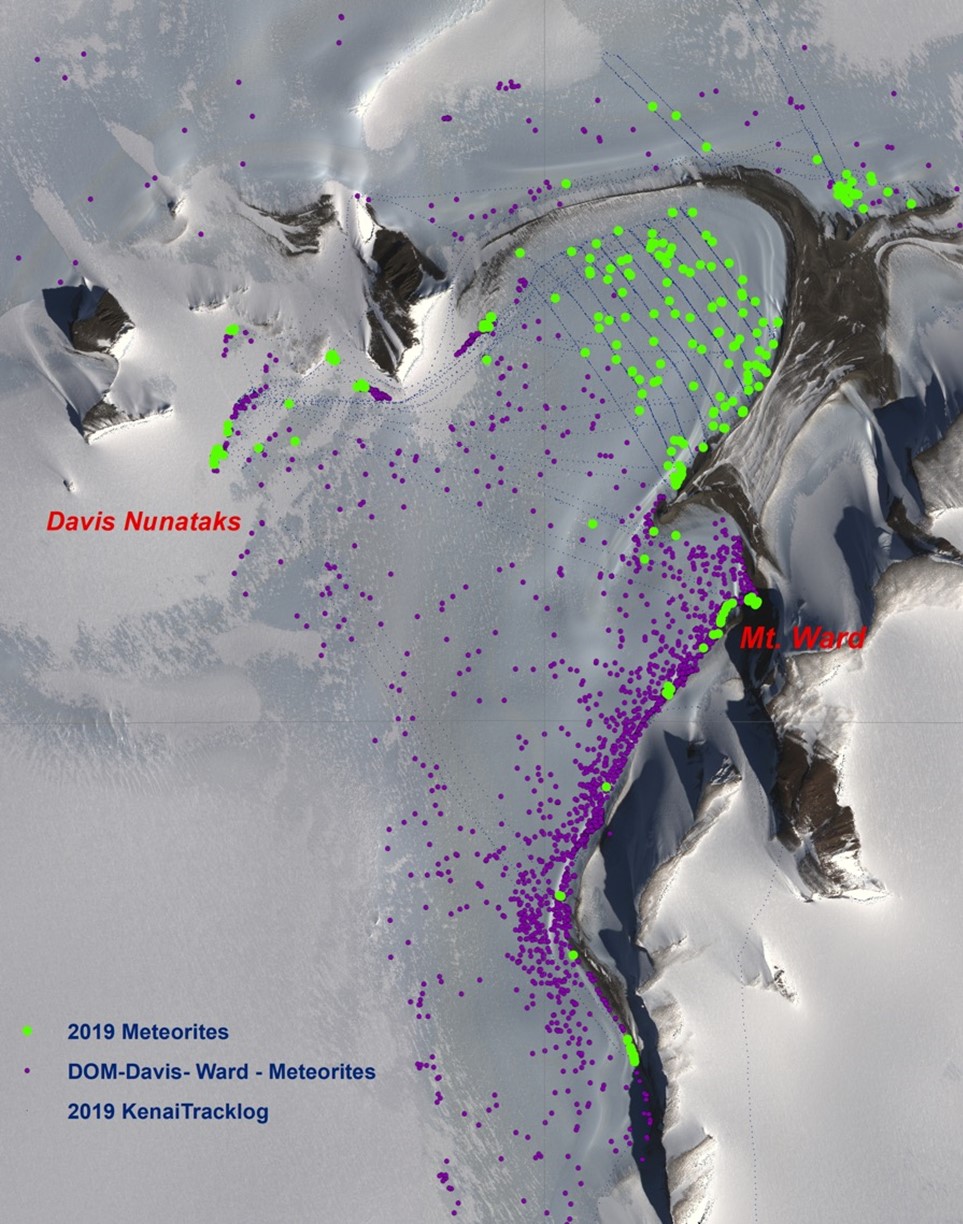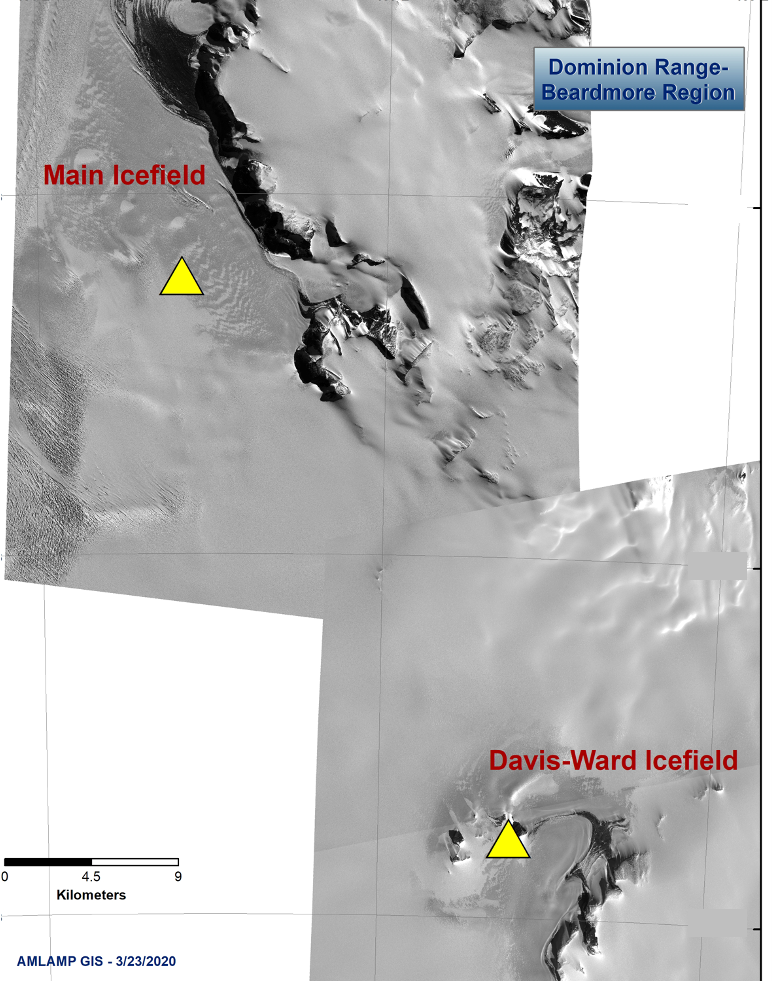Program News
Curator Comments
Kevin Righter, NASA-JSC
This newsletter announces the availability of 191 new meteorites collected from the 2018-19 ANSMET season in the Dominion Range (DOM). Samples include a CO3 chondrite and an L3.6 chondrite. In addition to these new samples, we announce the reclassification or pairing updates for many samples in our collection, including many carbonaceous chondrites.
New Meteorite Staff
We welcome Leslie Young to the meteorite curation group at JSC. Leslie graduated from Boise State with a master's degree in Earth Science with a concentration in geochemistry. We are excited to have Leslie working with us and welcome her to the JSC Astromaterials curation group.
Loan agreements / inventory
This past year we have been sending out expired loan agreements for Antarctic meteorite samples and annual inventory. A few of our principal investigators (PIs) have responded to these requests and returned their inventories and loans and we thank you for your time in working through the details of both documents. This has been particularly difficult for those of you who have held samples for several decades. Please remember these inventories will be annual and the loan agreement will be good for 5 years. We would just like to remind all of our PIs to please return your inventory and loan, otherwise we will need to ask that you return all the meteorite samples you currently have.
Reclassification and pairing updates
Many meteorites in our collection have been studied in more detail since their original classification and here we update classifications for a large number of meteorites, based on published data as well as additional microprobe analyses obtained at NASA-JSC.
Miller Range CO3
The Miller Range (MIL) is the source of over 200 CO3 chondrites. After the 2003-04 and 2005-06 ANSMET seasons, a MIL 03377 pairing group was established and currently has 5 members including the ~ 1.5 kg MIL 05013. Subsequent seasons (2007-08, 2009-10, 2011-12, 2013-14, and 2015-16) recovered many more, most of which were assigned to the large MIL 07099 pairing group. Some focused studies looking at all CO3 chondrites in this dense collection area (DCA) have revealed that members of the MIL 03377 and MIL 07099 pairing groups have the same cosmic ray exposure (CRE) age and overlapping Type II chondrule (FeO-rich) Cr2O3 contents. Additionally, Type II chondrule olivine Cr2O3 contents for the two member MIL 07673 pairing group overlaps completely with the other two large groups and were recovered very closely to many of those samples as well. Given a decade of perspective, and all this new information, we have combined the MIL 03377, MIL 07099, and MIL 07673 pairing groups into one - for a total of 199 samples.
On the other hand, the MIL 11069 pairing group remains distinct, and furthermore seems to have decidedly lower Type II chondrule olivine Cr2O3 contents than the other large group. Given the geographic location of these members and their olivine compositions, we add three additional samples to this group – MIL 11178, MIL 11187, and MIL 11261 – for a total of eight samples.
Many smaller masses remain unchecked or unstudied, but our confidence is based partly on Sears 2016 and similar magnetic susceptibility (MS) and olivine compositions among many of the ~199 members.
Dominion Range CO3
Pairing of CO3 chondrites recovered from the Dominion Range were updated in AMN vol. 44, no. 2 (Fall 2021). We would like to make one small addition to those reclassifications. DOM 03238 was recovered in the 2003-04 ANSMET season and initially classified as having anomalous properties. Since then, many new CO3 chondrites have been recovered and found in the Dominion Range. Comparison of DOM 03238 to many of these samples reveals that it has the same CRE age, Type II chondrule olivine Cr2O3 contents, and H, C, and N elemental and isotopic compositions. Initially thought to have a high magnetite component, its mode is only slightly higher than that measured in a number of DOM 08004 pairing group CO3 chondrites (Rubin and Li, 2019). Given all this new information, we reclassify DOM 03238 as a CO3 chondrite, and add it to the DOM 08004 pairing group.
Data supporting these new pairing updates for MIL and DOM CO3 chondrites were presented in Righter et al. (2021, 2022, 2023) and Rubin and Li (2019).
CR chondrites are actually CV reduced and EH Chondrites
In a recently published study, Prestgard et al. (2023) report new oxygen isotope data for CR chondrites and found three US Antarctic meteorites that are inconsistent with CR2 chondrite classification. Here we reclassify these three samples as follows, and according to the diagram below.
BUC 10933:
BUC 10933 classified in AMN vol. 36 no. 1 as a CR2 chondrite is reclassified as a CV reduced chondrite.
DOM 10085:
DOM 10085 classified in AMN vol. 37 no. 1 as a CR2 chondrite is reclassified as a CV reduced chondrite.
GRO 17060:
GRO 17060 classified in AMN vol. 44 no. 1 as a CR2 chondrite is reclassified as a EH3 chondrite.

LAP 031214 and LAP 031166
These two samples were classified as CM1/2 chondrite in AMN vol. 29, no. 1 and AMN vol. 29 no. 2, respectively. The LaPaz Icefield contains numerous CM1 and CM2 chondrites that have been studied extensively since their initial classification. A few of those studies have revealed the need for updated classifications.
Bates et al. (2020) implies that LAP 031166 is the same as LAP 02277 and that both are CM1 chondrites, based on XRD measurements of high phyllosilicate content.
Bates et al. (2020) and King et al. (2017) show that LAP 031214 is a CM2 chondrite due to lower phyllosilicate content than expected for CM1/2 chondrites and is the same as many CM2 chondrites.
In light of this information, we reclassify LAP 031166 as a CM1 chondrite and LAP 031214 as a CM2 chondrite.
MCY 05231
MCY 05231 was classified as a CM1/2 chondrite in AMN vol. 29, no. 2, and paired with MCY 05234. Since then, King et al. (2017) and Greenwood et al. (2019) have shown that MCY 05231 is actually a CM2 chondrite, based on its lower phyllosilicate content than expected for CM1/2 chondrites and more similar oxygen to other CM2 chondrites. It is likely instead paired with other CM2 chondrites recovered in the South Mackay Glacier Icefields MCY 92500, 92502, MCY 05230, and MCY 05251 and well as CM2 chondrite recovered in South Mackay Glacier by the National Program for Research in Antarctica (PNRA), Italy. in 2014 - MCY 14001, MCY 14004, and MCY 14014 samples.
Originally paired with MCY 05231, MCY 05234 is nearly 18 km away and if paired at all, it is more likely with the three other CM2 chondrites in the same area as MCY 05229, MCY 05242, and MCY 05245. However, in the absence of any new data for MCY 05234, we leave its classification unchanged.
PCA 02010
PCA 02010 and PCA 02012 (the latter paired with PCA 02011 and PCA 02050) were initially announced as CM2 chondrites in two different AMN vol. 26, no. 2 and vol. 27, no. 1, but not considered together. Studies since then have revealed that they have the same CRE age (1.2 Ma), similar petrography (Zolensky et al., 2021), and are very closely associated. Given this data we can confidently add PCA 02010 to the PCA 02011 pairing group.
EET 83226 and 83355
These two carbonaceous chondrites were paired in AMN vol. 10, no. 2 and then re-classified to C2 ungrouped chondrites (AMN vol. 17, no. 1) due to very unusual chemistry intermediate between CO and CM chondrites. There are many meteorites intermediate between CO and CM chondrites now and so this is a less unique characteristic than it was in 1995. In addition, these two samples have rarely been studied together allowing direct comparison. Recent work has suggested they are different including O, Cr, and Ti (Torrano et al., 2021), and EET 83355 has unusually high CRE age (78 Ma; Krietsch et al., 2021). Additionally, Cody Schultz, Taki Hiroi, and Ralph Milliken (Brown University) were kind enough to do an IR spectral comparison using the same approach for each, at the request of curator Righter.
Given the distinctive isotopic characteristics, the unusually old CRE age for EET 83355 (the age of EET 83226 is currently being undertaken for direct comparison), and the different modal analyses of these two samples gives us enough information to confidently unpair these two unusual meteorites. Their close find locations (~ 2 km) are coincidental.
CK chondrites from the Queen Alexandra Range
CK chondrites recovered from the Queen Alexandra Range are mainly from the Goodwin Nunatak region, but there is also one from the Foggy Bottom area. Five CK4 chondrites from Goodwin Nunatak were classified in AMN vol. 25, no. 1, and then two CK5 chondrites were announced in AMN vol. 25, no. 2. These were kept as separate pairing groups. However, examination of olivine and feldspar compositions of all seven Goodwin Nunatak CK chondrites indicates they can confidently be paired as CK4 chondrites. Olivine compositions vary from ~ 0.28 to 0.30 Fa, and several of the QUE 99s have feldspar of a range of compositions suggesting not quite equilibrated and thus more consistent with petrologic type 4. Given these olivine and feldspar compositions, and the close proximity of these sample locations in the field, all seven can be classified as CK4 chondrites (i.e., reclassification of QUE 99680 and 99681 from CK5 to CK4 chondrites). QUE 93007, on the other hand, is a geographic outlier nearly 8 km away from the other QUE 99 CK chondrites, has distinctly different olivine compositions, more equilibrated silicates including feldspars, and thus will remain unpaired as a distinct CK5 chondrite.

Small L5 pairing group from Larkman Nunatak
The 2004-05 ANSMET team collected 8 samples from the Larkman Nunatak area that appeared to the field team members to be paired. They were announced in AMN vol. 30, no. 1, and vol. 31, no. 1 without any pairing indicated. Reassessment of these 8 samples and application of the updated classification approach using SEM and visual inspection of the chips (they were originally classified using immersion oils), reveals that they are all L5 chondrites.
| LAR 04321 - L6 -> L5 | Fa25 and Fs20 |
| LAR 04329 - LL6 -> L5 | Fa25 and Fs20 |
| LAR 04330 - LL5 -> L5 -> L5 | Fa25 and Fs20 |
| LAR 04339 - L5 -> L5 (no change) | Fa25 and Fs20 |
| LAR 04348 - L6 -> L5 | Fa25 and Fs20 |
| LAR 04352 - L5 -> L5 (no change) | Fa25 and Fs20 |
| LAR 04356 - L5 -> L5 (no change) | Fa25 and Fs20 |
| LAR 04389 - LL6 -> L5 | Fa25 and Fs20 |
References
- Bates, H. C., King, A.J., Donaldson Hanna, K.L., Bowles, N.E., and Russell, S. S. (2020) Linking mineralogy and spectroscopy of highly aqueously altered CM and CI carbonaceous chondrites in preparation for primitive asteroid sample return. Meteoritics & Planetary Science 55, 77-101.
- Greenwood, R.C., Howard, K.T., King, A.J., Lee, M.R., Burbine, T.H., Franchi, I.A., Anand, M., Findlay, R. and Gibson, M. (2019) Oxygen Isotope Evidence for Multiple CM Parent Bodies: What Will We Learn from the Hayabusa2 and OSIRIS-REx Sample Return Missions?. 50th Annual Lunar and Planetary Science Conference, abstract #3191
- King, A. J., Schofield, P. F., and Russell, S. S. (2017) Type 1 aqueous alteration in CM carbonaceous chondrites: Implications for the evolution of water-rich asteroids. Meteoritics & Planetary Science 52, 1197-1215.
- Krietsch, D., Busemann, H., Riebe, M. E., King, A. J., Alexander, C. M. D., and Maden, C. (2021) Noble gases in CM carbonaceous chondrites: Effect of parent body aqueous and thermal alteration and cosmic ray exposure ages. Geochimica et Cosmochimica Acta 310, 240-280.
- Prestgard, T., Beck, P., Bonal, L., Eschrig, J., Gattacceca, J., Sonzogni, C., and Krämer Ruggiu, L. (2023) The parent bodies of CR chondrites and their secondary history. Meteoritics & Planetary Science, early view
- Righter, K., Alexander, C., Foustoukos, D., Mertens, C.A.K., Busemann, H., Schutt, J. and Space, J. (2021) Pairing Relations Within CO3 Chondrites Recovered at the Dominion Range and Miller Range, Transantarctic Mountains. 84th Annual Meeting of the Meteoritical Society, abstract # 6191.
- Righter, K., Busemann, H., Eckart, L.M., Alexander, C., Schutt, J., Harvey, R.P. and Karner, J. (2022) Survey of Dominion Range (DOM) and Miller Range (MIL) CO3 Carbonaceous Chondrites: Magnetic Susceptibility and Type II Chondrule Olivine Cr2O3 Contents and Their Implications for Pairing. In 53rd Lunar and Planetary Science Conference, abstract # 2414.
- Righter, K., Alexander, C., Foustoukos, D., Eckart, L.M., Mertens, C.A.K., Busemann, H., Maden, C., Schutt, J., Satterwhite, C.E., Harvey, R.P., Pando, K., and Karner, J. (2023) Pairing Relations Within CO3 Chondrites Recovered at the Dominion Range and Miller Range, Transantarctic Mountains; constraints from chondrule olivines, noble gas and H, C, N bulk and isotopic compositions. Meteoritics and Planetary Science, in revision
- Rubin, A. E., and Li, Y. (2019) Formation and destruction of magnetite in CO3 chondrites and other chondrite groups. Geochemistry 79, 125528.
- Torrano, Z. A., Schrader, D. L., Davidson, J., Greenwood, R. C., Dunlap, D. R., and Wadhwa, M. (2021) The relationship between CM and CO chondrites: Insights from combined analyses of titanium, chromium, and oxygen isotopes in CM, CO, and ungrouped chondrites. Geochimica et Cosmochimica Acta 301, 70-90.
- Zolensky, M.E., Takenouchi, A., Mikouchi, T., Gregory, T., Nishiizumi, K., Caffee, M.W., Velbel, M.A., Ross, D.K., Zolensky, A., Le, L. and Imae, N. (2021) The nature of the CM parent asteroid regolith base on cosmic ray exposure ages. Meteoritics & Planetary Science 56, 49-55
Report from the Smithsonian
Cari Corrigan, Research Geologist (Dept. of Mineral Sciences)
This newsletter announces the classification of 191 new meteorites (and two terrestrial rocks). The most exciting news in the Department of Mineral Sciences is that we have been actively digitizing the data packs that accompany each and every Antarctic meteorite when it is permanently transferred to the Smithsonian. All information about the meteorites, including every subsampling that it has experienced (how much mass, to whom it was delivered, etc.) is contained within these data packs, so the ability to have these archived digitally is of huge benefit - both to us and to the community long-term. We thank the Smithsonian Institution Collections Care and Preservation Fund for awarding the funding to the Antarctic Meteorite Collection, and I personally thank Julie Hoskin and Kelsey Falquero for writing the proposals to obtain the funding and organizing this massive undertaking (which is approximately halfway completed).
ANSMET Report
Jim Karner, University of Utah
Ralph Harvey, Case Western
2023-2024 Season Preview- The Return to Davis-Ward!

It's been a while, folks. We missed you SO MUCH!!!!
After three seasons cancelled due to pandemics and related logistical shortfalls, ANSMET stands poised to return to the field this December. At risk of jinxing ourselves, ANSMET leadership now feels pretty solid about the upcoming 2023-2024 season, so it's time to pull back the curtain and fill you in on the details about what we have planned. Our target for the coming field season is fairly predictable. The Davis-Ward icefields, which sit between and around the Davis Nunataks and Mt. Ward in the headwaters region of the Beardmore Glacier, have been a repeated target of 7 previous expeditions, resulting in the recovery of over 3000 meteorite specimens. After all that work, we're within striking distance of finishing our systematic searching efforts. That's a significant priority for us, and anytime we finish at a field site (usually after extending that target date several times) it's a landmark occasion for us.
Formal planning for the 23-24 season truly began years ago. When our last field season ended in January of 2020, we had assumed we'd be back in about 10 months, so we left a substantial amount of gear and fuel carefully cached at our campsite. That makes a tremendous amount of sense, of course- every bit of stuff cached becomes something we don't need to fly back out to Davis-Ward for the next season, a huge logistical savings. That cache is proof we were planning to revisit Davis-Ward in the next season, 2020-2021. But of course history had other plans, and when we next see that gear it will have been almost a full 4 years since we promised we'd be back soon.
The good news of course is that our plans for the coming season are VERY mature- they've been refined and carefully hammered into shape for years, far longer than a "normal" season. There's "bad" to temper the good, however; the maturity of our plans has been offset by reductions in NSF's abilities to support deep field parties and almost complete overturn among the support actually staff that makes our work happen. Relationships with supporting staff, program officers, contractors, and other entities that we'd carefully cultivated for years are gone, wiped out by a stinkin' little virus. On the other end of the pipeline, our grant funding also expired during the pandemic, so new proposals had to be written, submitted, reviewed and (thankfully) funded. In a nutshell, while we know exactly what we want to get done at Davis-Ward and exactly how to do it, paving the path to the site has been (and remains) a challenging work in progress. We are excited, cautious, and hopeful.
The Plans
The 2023-2024 ANSMET field season will (hopefully) follow the pattern established by our most recent seasons but starting about a week later than usual. A team of eight field party members will include ANSMET leaders Jim Karner and mountaineer Brian Rougeux, along with ANSMET veteran Minako Righter. Newbies will include Lauren Edgar, Jon Friedrich, Robert Citron, Erin Gibbons, and Daniela Hernandez. The team will depart the US at the end of November, arrive in McMurdo 3-5 days later, and get put into the field about 7-10 days after that (nominally mid-December). Brian Rougeux and a partner will be sent out to the Davis-Ward campsite by Twin Otter several days before that to groom a ski way that will allow the use of a larger Basler aircraft for our main group put-in. That advance team will also have the daunting task of digging out a cache of supplies that's been exposed to three Antarctic winters.

Once the whole team is at Davis-Ward, meteorite recovery becomes the priority. Our first goal for the season is completion of systematic searching; but in the case of Davis-Ward, it's not as simple as a limited number of traverses. The remaining blue ice has a fairly dense covering of wind-blown rocks disguising the meteorites mixed in; and the remaining moraine searching is of course even slower work, with field team members trying to distinguish the dark-chocolate chunks (the meteorites) from the semi-sweet bits (the Ferrar Dolerite). Weather and logistical delays could (as always) play a big role in the coming season; but we're hopeful that one side-effect of our late start, further past the Antarctic spring, will be fewer early-season windstorms. If things go really well, sometime in early January the systematic searches will be completed, and a mission accomplished vibe will settle across Davis-Ward. But rather than settle down on the infamous Davis-Ward "Beach" for a well-deserved late-summer break, the field team is scheduled to pack up and move on to the nearby Dominion Range Main icefield. That potential move will include the first snowfield traverse we've done in about a decade, with a Twin Otter ferrying heavy or high-volume gear (ANSMET's famous "Flying Traverse"). We're very confident in the ability of our mountaineers to guide us safely along the route, particularly given that satellite imagery of the site is amaze-balls!

The new target, the Dominion Range Main icefield, was first explored in 1985, during the same first-order reconnaissance-focused season that discovered Davis-Ward and several other sites in the region. The potential for the Dominion Range Main icefield to bear a significant meteorite concentration was confirmed during a more detailed reconnaissance effort in 2003. There's a lot of blue ice there, maybe twice as much area as at Davis-Ward; but the setting is very different. Whereas Davis-Ward is a deflating ice tongue walled-in on three sides, Dominion Main is blue ice that is slowed and stranded by a sidewall mountain range as it tries to empty gradually into the Beardmore Glacier. Based on what we know about icefields (which may be extensive, but admittedly is still mostly anecdotal), this setting implies wide variations in ice velocity, ablation rates and surface age across the exposed surface, which fits with the accompanying variations in the concentration of meteorite samples seen previously. Suffice it to say we know the meteorites are there and have ferreted-out a few of their favorite hiding spots; but our understanding of the site as a whole is woefully incomplete. January 2024 will be the first time we'll go there with a focus on systematic recovery of meteorites, and we'll just have to wait to see whether it's truly a site for the ages.
I'm going to close here with a quick shout-out to the planetary materials community, ExMAG and others. The annual ExMAG meeting took place last month and community support for ANSMET was abundantly clear. ExMAG and others reminded NSF's Office of Polar Programs how much they value ANSMET as a critical part of NASA's mission, and helped NSF understand they're obligated to support ANSMET even if the project's goals don't address their own mission. Without your support, the 2023-24 season might indeed not be taking place, so we are extremely grateful, thank you! And with your continued support (and reminders to NSF that you like us), perhaps ANSMET once again can recover specimens on a consistent, yearly basis.
Acknowledgements: ANSMET work is supported by NASA's Near Earth Object Observations program, grant 80NSSC23K1520. Geospatial support for this work provided by the Polar Geospatial Center under NSF-OPP awards 1043681, 1559691, and 2129685.
